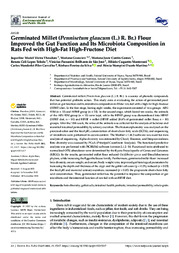Germinated millet (Pennisetum glaucum (L.) R. Br.) flour improved the gut function and its microbiota composition in rats fed with high-fat high-fructose diet.
Germinated millet (Pennisetum glaucum (L.) R. Br.) flour improved the gut function and its microbiota composition in rats fed with high-fat high-fructose diet.
Author(s): THEODORO, J. M. V.; GRANCIERI, M.; GOMES, M. J. C.; TOLEDO, R. C. L.; SÃO JOSÉ, V. P. B. DE; MANTOVANI, H. C.; CARVALHO, C. W. P. de; SILVA, B. P. DA; MARTINO, H. S. D.
Summary: Germinated millet (Pennisetum glaucum (L.) R. Br.) is a source of phenolic compounds that has potential prebiotic action. This study aims at evaluating the action of germinated pearl millet on gut function and its microbiota composition in Wistar rats fed with a high-fat high-fructose (HFHF) diet. In the first stage, lasting eight weeks, the experiment consisted of two groups: AIN93M (n = 10) and HFHF group (n = 20). In the second stage, which lasted ten weeks, the animals of the AIN-93M group (n = 10) were kept, while the HFHF group was dismembered into HFHF (HFHF diet, n = 10) and HFHF + millet (HFHF added 28.6% of germinated millet flour, n = 10) groups. After the 18th week, the urine of the animals was collected for the analysis of lactulose and mannitol intestinal permeability by urinary excretion. The histomorphometry was analyzed on the proximal colon and the fecal pH, concentration of short-chain fatty acids (SCFA), and sequencing of microbiota were performed in cecum content. The Mothur v.1.44.3 software was used for data analysis of sequencing. Alpha diversity was estimated by Chao1, Shannon, and Simpson indexes. Beta diversity was assessed by PCoA (Principal Coordinate Analysis). The functional predictive analysis was performed with PICRUSt2 software (version 2.1.2?b). Functional traits attributed to normalized OTU abundance were determined by the Kyoto Encyclopedia of Genes and Genomes (KEGG). In the results, germinated millet flour reduced Oscillibacter genus and Desulfobacterota phylum, while increasing the Eggerthellaceae family. Furthermore, germinated millet flour: increased beta diversity, cecum weight, and cecum/body weight ratio; improved gut histological parameters by increasing the depth and thickness of the crypt and the goblet cell count (p < 0.05); reduced (p < 0.05) the fecal pH and mannitol urinary excretion; increased (p < 0.05) the propionate short-chain fatty acid concentration. Thus, germinated millet has the potential to improve the composition of gut microbiota and the intestinal function of rats fed with an HFHF diet.
Publication year: 2022
Types of publication: Journal article
Unit: Embrapa Food Technology
Observation
Some of Embrapa's publications are published as ePub files. To read them, use or download one of the following free software options to your computer or mobile device. Android: Google Play Books; IOS: iBooks; Windows and Linux: Calibre.
Access other publications
Access the Agricultural Research Database (BDPA) to consult Embrapa's full library collection and records.
Visit Embrapa Bookstore to purchase books and other publications sold by Embrapa.

